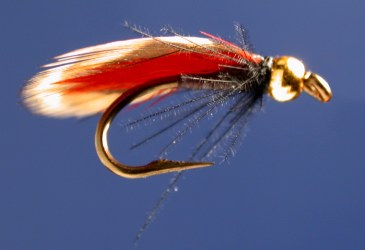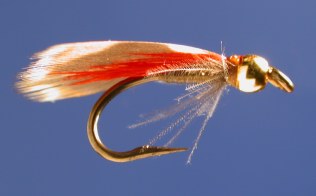Invicta Flies - Spaatz
The first fly I ever tied was an unconventional potpourri of various odds and ends. I used an old, small bait hook and some sewing thread. After wrapping the thread along the shank, I tied on a small bit of marabou plucked from a crappie jig. I found a mottled brown feather in the yard and tied this on top of the marabou, then strung a small gold plastic bead I found in the carpet onto the thread and wound the thread about to hold it on top. A couple overhand knots held it all together, with a drop of Super Glue. I didn't know what I was doing, didn't even have a vise. I just threw it all together, then took it out to fish. I caught a good number of crappie and perch on the first go-around, my first fly proving rather productive. I still have that fly, but now I tie it in more "conventional" ways. It is named after the street I lived on at the time when I tied the first one.

Hook: Mustad 3906B, #12-14
Head: 5/32 brass bead, gold
Body: tying thread
Collar: black CDC fibers
Underwing: red marabou
Wing: hen pheasant body feathers
Tying Instructions:
1) Crimp the hook bard and place the bead on the hook. Insert the hook in the vise and push the bead up to the hook eye. Secure the thread just behind the bead. Wrap the thread to the bend, then forward again to form the body. For a thicker body, simply repeat.
2) Just behind the eye, tie in a very sparse clump of marabou so the tips extend just beyond the bend. Three or four fibers should do it, using the fluffier type rather than the fine straight fibers. For more on marabou, click here. Clip the excess.
3) Select a well-marked body feather from a ringneck hen pheasant. Other birds, such as mallard or grouse also work well. Trim off the tip at a length of about half a hook gap longer than the entire hook. Insert this into the bead and take a few wraps of thread to secure it on top.
4) For the collar, you can either use a dubbing loop, inserting the CDC fibers then spinning, or tie the CDC feather in behind the bead by the tip and winding for two turns. Tie off and clip the excess. Trim any excessively long fibers... a judgment call, as sometimes overly long CDC fibers can add to the pattern and simulate legs or antennae.
5) Whip finish and coat the thread wraps behind the bead with cement.
NOTE: This fly is most productive (lakes or streams) when retrieved in very short, quick, erratic strips. This could imitate small fry, diving sedges, or larger emergers.
 Olive version. Use olive thread and dun CDC for the collar.
|
 |